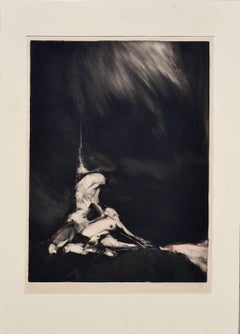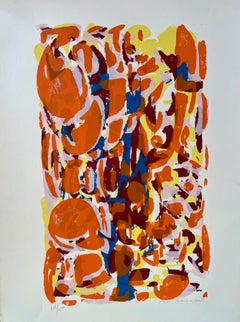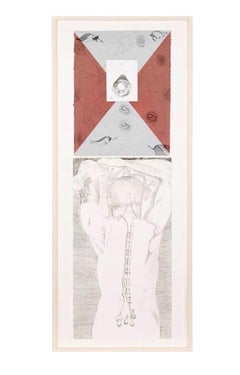Patricia Way Art
American
Patricia Way studied art at Stanford University, where she completed her master of fine arts degree. Her work explores the exterior of her waking hours and the interior world of her unconscious dreams. She exhibited in Oregon in 1978 and at the Chicago Arts Council in 1981.
to
1
Overall Width
to
Overall Height
to
1
1
1
1
1
1
1
1
10,138
2,779
1,375
1,368
1
Artist: Patricia Way
Vintage Abstract Figurative Etching -- "Embrace"
By Patricia Way
Located in Soquel, CA
Vintage abstract figural "Embrace", a lithograph by Patricia Ann Way (American, 20th Century). Signed "Patricia Way" and dated "76" lower right. Slight crease to lower center and s...
Category
1970s Abstract Expressionist Patricia Way Art
Materials
Paper, Ink, Etching
Related Items
abstract composition
By Marie Raymond
Located in Belgrade, MT
This color lithograph is part of my private collection since the 1970's. Marie Raymond was a pioneer post WWII painter of her generation. She was a lyrical abstractionist of her time...
Category
Mid-20th Century Abstract Expressionist Patricia Way Art
Materials
Color, Lithograph
Large Italian Aquatint Etching Francesco Clemente Neo Expressionist Avant Garde
By Francesco Clemente
Located in Surfside, FL
Francesco Clemente (Italian b. 1952),
'This side up / Telemone #2,
1981
Medium: Intaglio hard ground etching, color aquatint, drypoint, and soft-ground etching with chine collé (ha...
Category
1980s Abstract Expressionist Patricia Way Art
Materials
Drypoint, Etching, Aquatint, Intaglio
"Venus Noire", Rufino Tamayo, Figurative Abstraction, Etching, 30x22 in.
By Rufino Tamayo
Located in Dallas, TX
"Venus Noire" by Rufino Tamayo is a Figurative Abstraction lithograph limited edition measuring 30x22 in. The piece is framed beautifully with a white mat in a gold and black frame u...
Category
1960s Abstract Expressionist Patricia Way Art
Materials
Lithograph
$4,850
H 30 in W 22 in D 1 in
"Femme Au Collant Rose", Rufino Tamayo, Figurative Abstraction, Etching, 30x22
By Rufino Tamayo
Located in Dallas, TX
"Femme Au Collant Rose" by Rufino Tamayo is a Figurative Abstraction lithograph limited edition measuring 30x22 in. The piece is framed beautifully with a white mat in a gold and bla...
Category
1960s Abstract Expressionist Patricia Way Art
Materials
Etching
$4,850
H 30 in W 22 in D 1 in
Rome Qantas Airlines travel poster linen backed
Located in Spokane, WA
Original Vintage "Rome Qantas" Vintage Travel Poster, Linen Backed, 1960s. Excellent condition. See images. Abstract style design of ancient Roman ruins.
An original mid-century...
Category
1960s Abstract Expressionist Patricia Way Art
Materials
Offset
"Hombre Blanco", Rufino Tamayo, Figurative Abstraction, Lithograph, 30x22 in.
By Rufino Tamayo
Located in Dallas, TX
"Hombre Blanco" by Rufino Tamayo is a Figurative Abstraction mixografia in color limited edition measuring 30x22 in. The piece is framed beautifully with...
Category
1970s Abstract Expressionist Patricia Way Art
Materials
Etching
$6,800
H 30 in W 22 in D 1 in
Serigraphie Fernand Leger
By Fernand Léger
Located in Belgrade, MT
This print is part of my private collection. They were published in a numbered unsigned edition of 1000, and a signed edition of 200, printed by Serifraphie Fernand Leger, Paris and ...
Category
Mid-20th Century Abstract Expressionist Patricia Way Art
Materials
Lithograph
Torero (de-accessioned from the Denver Art Museum) Engraving Signed 17/30 Framed
By Stanley William Hayter
Located in New York, NY
Stanley William Hayter
Torero (de-accessioned from the Denver Art Museum), 1929-1933
Engraving on laid paper, third (final) state, on heavy BFK Rives...
Category
1930s Abstract Expressionist Patricia Way Art
Materials
Engraving, Etching
$2,800
H 15.5 in W 11.5 in D 0.5 in
International Very Special Arts signed, inscribed Abstract Expressionist poster
By Paul Jenkins
Located in New York, NY
Paul Jenkins
International Very Special Arts Festival poster, 1994
hand signed and dated by Paul Jenkins
Measures: 37 inches (vertical) x 25 inches (horizontal)
Ships rolled in a tub...
Category
1990s Abstract Expressionist Patricia Way Art
Materials
Offset, Ballpoint Pen, Lithograph
Frank Stella - NY State Columbus Centenary, Lithograph, Hand Signed, Ed. of 100
By Frank Stella
Located in New York, NY
Frank Stella
The New York State Christopher Columbus Quincentenary Commission, 1991
Offset Lithograph Printed in Colors
Signed and dated by the artist in ink on the lower right fron...
Category
1990s Abstract Expressionist Patricia Way Art
Materials
Ink, Lithograph, Offset
$4,500
H 39.5 in W 23.5 in
"Cabeza en Gris", Rufino Tamayo, Figurative Abstraction, Lithograph, 30x22 in.
By Rufino Tamayo
Located in Dallas, TX
"Cabeza en Gris" by Rufino Tamayo is a Figurative Abstraction lithograph limited edition measuring 30x22 in. The piece is framed beautifully with a white mat with a silver liner and ...
Category
1970s Abstract Expressionist Patricia Way Art
Materials
Etching
$7,650
H 30 in W 22 in D 1 in
"Manos en Rojo", Rufino Tamayo, Red Hands, Abstraction, Etching, 22x30 in.
By Rufino Tamayo
Located in Dallas, TX
"Manos en Rojo" by Rufino Tamayo is a Figurative Abstraction lithograph limited edition measuring 22x30 in. The piece is framed beautifully with a white mat in a silver and black fr...
Category
1970s Abstract Expressionist Patricia Way Art
Materials
Etching
$5,700
H 22 in W 30 in D 1 in
Patricia Way art for sale on 1stDibs.
Find a wide variety of authentic Patricia Way art available for sale on 1stDibs. You can also browse by medium to find art by Patricia Way in etching, ink, paper and more. Much of the original work by this artist or collective was created during the 1970s and is mostly associated with the abstract style. Not every interior allows for large Patricia Way art, so small editions measuring 22 inches across are available. Customers who are interested in this artist might also find the work of Michael Steiner, Carmen Cicero, and Pat Steir. Patricia Way art prices can differ depending upon medium, time period and other attributes. On 1stDibs, the price for these items starts at $1,550 and tops out at $1,550, while the average work can sell for $1,550.


